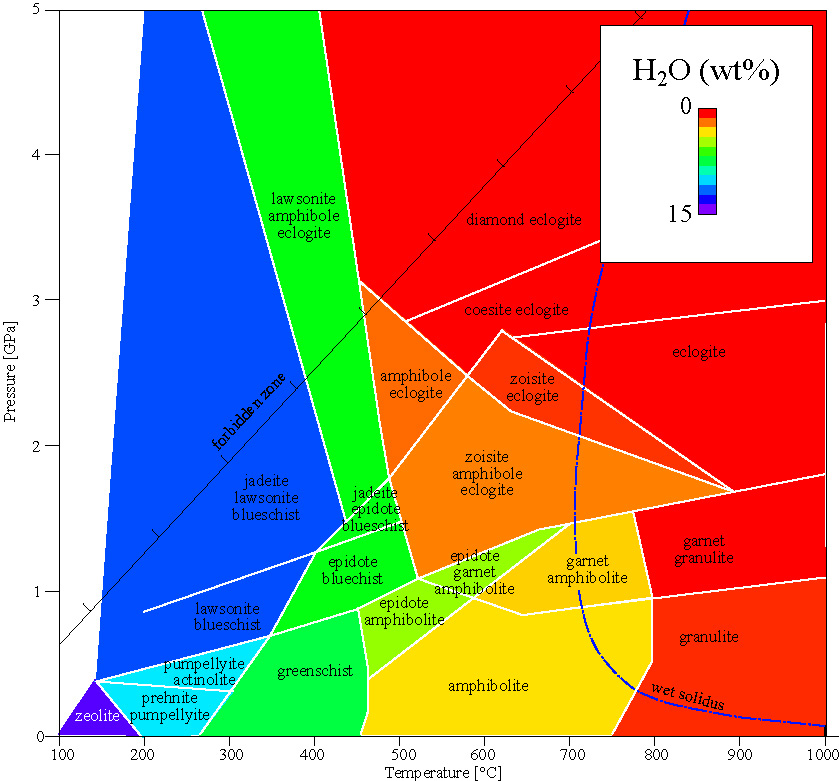
Solid Solutions and Exchange Vectors
Some minerals (e.g., quartz) have constant composition. However, most minerals are solid solutions that undergo compositional change in response to PTX (pressure, temperature, composition) changes. Garnet is an example of a relatively simple solid solution, with substitution occurring on only one site:
| mineral | end members | exchange vector |
|---|---|---|
| olivine | forsterite Mg2SiO4 <—> fayalite Fe2SiO4 | Fe2+ <—> Mg2+ |
| plagioclase | albite NaAlSi3O8 <—> anorthite CaAl2Si2O8 | Na+ Si4+ <—> Ca2+ Al3+ |
| amphibole | tremolite Ca2Mg5Si8O22(OH)2 <—> tschermakite Ca2(Mg3Al2)(Al2Si6)O22(OH)2 | VIMg2+ IVSi4+ <—>VIAl3+ IVAl3+ (tschermak exchange) |
| mica | muscovite KAl2(AlSi3)O10(OH)2 <—> phengite KMgAlSi4O10(OH)2 | VIAl3+ IVAl3+ <—> VIMg2+ IVSi4+(inverse tschermak exchange) |


| facies | minerals | notes |
|---|---|---|
| basalt and gabbro protoliths | plagioclase NaAlSi3O8-CaAl2Si2O8 + pyroxene CaSiO3-MgSiO3-FeSiO3 | . |
| zeolite facies | common zeolites: laumontite, wairakite, analcime (Na,Ca)AlSiO(OH)x | zeolites: channel structure makes them useful for engineering
common textures: in cracks, alteration of feldspar or glass |
| greenschist facies | albite + epidote + actinolite + chlorite + quartz
albite NaAlSi3O8 takes up Na, Al, Si epidote CaAlSiO(OH)x takes up Ca actinolite Ca2(Fe,Mg)5Si8O22(OH)2 takes up Fe, Mg chlorite (Mg,Fe)(AlSi)O(OH)x |
. |
| albite-epidote amphibolite facies | albite + epidote + hornblende + quartz
albite NaAlSi3O8 takes up Na, Al, Si epidote CaAlSiO(OH)x takes up Ca hornblende (K,Na)(Ca,Fe,Mg)(AlSi)O22(OH)2 |
modal proportion of albite decreases, Na enters amphibole
modal proportion of chlorite decreases, Fe + Mg enters amphibole |
| amphibolite facies | plagioclase + hornblende + quartz | epidote replaced by intermediate plagioclase
remainder of elements in hornblende |
| granulite facies | orthopyroxene + clinopyroxene + plagioclase + quartz | must have 2 pyroxenes; can also have hornblende or garnet |
| blueschist facies | glaucophane Na2Mg3Al2Si8O22(OH)2
lawsonite or epidote CaAlSiO(OH)x |
high P, low T |
| eclogite facies | omphacite (Na,Al,Mg,Fe)Si2O6
garnet (Ca,Mg,Fe,Mn)3Al2Si3O12 |
high P, high T |
| coesite-eclogite facies | coesite SiO2
diamond C majorite Mg4Si4O12 |
pressures >2.5 GPa |
| facies series | tectonic setting | minerals present | minerals absent |
|---|---|---|---|
| low P (Buchan) | crustal extension | andalusite, sillimanite, cordierite | staurolite, kyanite |
| crustal thickening | medium P (Barrovian) | kyanite, sillimanite, staurolite | cordierite |
| subduction | high P (Franciscan) | kyanite | staurolite |